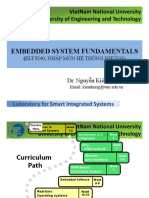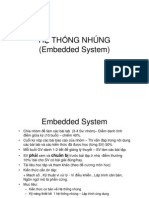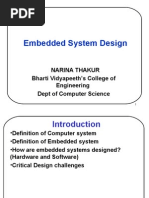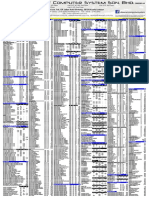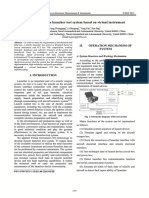0 ratings0% found this document useful (0 votes)
38 viewsLecture - 07 - Embedded Systems Introduction
Lecture - 07 - Embedded Systems Introduction
Uploaded by
Tú Phạm Anh1. Embedded systems are information processing systems embedded into larger products like appliances, vehicles, medical equipment. They are designed to perform dedicated functions with real-time constraints.
2. Embedded systems must be dependable, efficient, and dedicated to a specific application to minimize resources and maximize robustness. Many must also meet hard real-time constraints to react to stimuli within a specified time or a catastrophe could result.
3. Embedded systems are frequently connected to physical environments through sensors and actuators, and are typically reactive systems that depend on input and state. They are distinguished from general purpose computing by having fewer known applications at design-time and being not programmable by end users.
Copyright:
© All Rights Reserved
Available Formats
Download as PPTX, PDF, TXT or read online from Scribd
Lecture - 07 - Embedded Systems Introduction
Lecture - 07 - Embedded Systems Introduction
Uploaded by
Tú Phạm Anh0 ratings0% found this document useful (0 votes)
38 views8 pages1. Embedded systems are information processing systems embedded into larger products like appliances, vehicles, medical equipment. They are designed to perform dedicated functions with real-time constraints.
2. Embedded systems must be dependable, efficient, and dedicated to a specific application to minimize resources and maximize robustness. Many must also meet hard real-time constraints to react to stimuli within a specified time or a catastrophe could result.
3. Embedded systems are frequently connected to physical environments through sensors and actuators, and are typically reactive systems that depend on input and state. They are distinguished from general purpose computing by having fewer known applications at design-time and being not programmable by end users.
Original Title
lecture_07_embedded systems introduction
Copyright
© © All Rights Reserved
Available Formats
PPTX, PDF, TXT or read online from Scribd
Share this document
Did you find this document useful?
Is this content inappropriate?
1. Embedded systems are information processing systems embedded into larger products like appliances, vehicles, medical equipment. They are designed to perform dedicated functions with real-time constraints.
2. Embedded systems must be dependable, efficient, and dedicated to a specific application to minimize resources and maximize robustness. Many must also meet hard real-time constraints to react to stimuli within a specified time or a catastrophe could result.
3. Embedded systems are frequently connected to physical environments through sensors and actuators, and are typically reactive systems that depend on input and state. They are distinguished from general purpose computing by having fewer known applications at design-time and being not programmable by end users.
Copyright:
© All Rights Reserved
Available Formats
Download as PPTX, PDF, TXT or read online from Scribd
Download as pptx, pdf, or txt
0 ratings0% found this document useful (0 votes)
38 views8 pagesLecture - 07 - Embedded Systems Introduction
Lecture - 07 - Embedded Systems Introduction
Uploaded by
Tú Phạm Anh1. Embedded systems are information processing systems embedded into larger products like appliances, vehicles, medical equipment. They are designed to perform dedicated functions with real-time constraints.
2. Embedded systems must be dependable, efficient, and dedicated to a specific application to minimize resources and maximize robustness. Many must also meet hard real-time constraints to react to stimuli within a specified time or a catastrophe could result.
3. Embedded systems are frequently connected to physical environments through sensors and actuators, and are typically reactive systems that depend on input and state. They are distinguished from general purpose computing by having fewer known applications at design-time and being not programmable by end users.
Copyright:
© All Rights Reserved
Available Formats
Download as PPTX, PDF, TXT or read online from Scribd
Download as pptx, pdf, or txt
You are on page 1of 8
1
Embedded Systems
Embedded systems (ES) = information processing
systems embedded into a larger product
Examples:
Main reason for buying is not information processing
Swiss Federal Computer Engineering
Institute of Technology 1-1 and Networks Laboratory
Characteristics of Embedded Systems (1)
Must be dependable:
Reliability: R(t) = probability of system working
correctly provided that it was working at t=0
Maintainability: M(d) = probability of system working
correctly d time units after error occurred.
Availability: probability of system working at time t
Safety: no harm to be caused
Security: confidential and authentic communication
Even perfectly designed systems can fail if the assumptions about
the workload and possible errors turn out to be wrong.
Making the system dependable must not be an after-thought, it must
be considered from the very beginning.
Swiss Federal Computer Engineering
Institute of Technology 1-2 and Networks Laboratory
Characteristics of Embedded Systems (2)
Must be efficient:
Energy efficient
Code-size efficient (especially for systems on a chip)
Run-time efficient
Weight efficient
Cost efficient
Dedicated towards a certain application: Knowledge about
behavior at design time can be used to minimize resources and to
maximize robustness.
Dedicated user interface.
Swiss Federal Computer Engineering
Institute of Technology 1-3 and Networks Laboratory
Characteristics of Embedded Systems (3)
Many ES must meet real-time constraints:
A real-time system must react to stimuli from the controlled
object (or the operator) within the time interval dictated by the
environment.
For real-time systems, right answers arriving too late are wrong.
„A real-time constraint is called hard, if not meeting that
constraint could result in a catastrophe“ [Kopetz, 1997].
All other time-constraints are called soft.
A guaranteed system response has to be explained without
statistical arguments.
Swiss Federal Computer Engineering
Institute of Technology 1-4 and Networks Laboratory
Characteristics of Embedded Systems (4)
Frequently connected to physical environment through
sensors and actuators,
Hybrid systems (analog + digital parts).
Typically, ES are reactive systems:
„A reactive system is one which is in continual interaction
with is environment and executes at a pace determined by
that environment“ [Bergé, 1995]
Behavior depends on input and current state.
automata model often appropriate,
Swiss Federal Computer Engineering
Institute of Technology 1-5 and Networks Laboratory
Comparison
Embedded Systems General Purpose Computing
Few applications that are Broad class of applications.
known at design-time.
Not programmable by end Programmable by end user.
user.
Fixed run-time requirements Faster is better.
(additional computing power
not useful).
Criteria:
Criteria:
• cost
• cost
• pow
• aver
er
age
cons
spee
ump
d
tion
• Federal
Swiss pred 1-6
Computer Engineering
Institute of Technology and Networks Laboratory
icta
Trends …
Embedded Systems overtook market of PCs.
Ubiquitous and pervasive computing:
Information anytime, anywhere; building ambient intelligence
into our environment; internet of things:
• Wearable computers
• “Smart Labels” on consumer products
• Intelligent buildings
• Environmental Monitoring
• Traffic control and communicating automobiles
Embedded systems provide the basic technology.
Swiss Federal Computer Engineering
Institute of Technology 1-7 and Networks Laboratory
Trends …
Communicating embedded systems, very often wireless.
Higher degree of integration on a single chip:
memory + processor + I/O-units + (wireless) communication
network on chip for communication between units
Multiprocessor Systems on a Chip (MPSoC)
Microsystems that contain energy harvesting and sensing in
addition
Software increasing (amount and complexity).
Low power and energy constraints (portable or unattended
devices). Temperature constraints (overheating).
Increased interest in energy harvesting.
Swiss Federal Computer Engineering
Institute of Technology 1-8 and Networks Laboratory
You might also like
- Embedded Systems in Industrial Application PDFDocument46 pagesEmbedded Systems in Industrial Application PDFnavabnavab786No ratings yet
- Kath Exercise 1.1, 1.2, 2.1 & 2.2Document9 pagesKath Exercise 1.1, 1.2, 2.1 & 2.2Kathlyn TajadaNo ratings yet
- Introduction To Embedded System Design: © Lothar Thiele ETH Zurich, SwitzerlandDocument51 pagesIntroduction To Embedded System Design: © Lothar Thiele ETH Zurich, SwitzerlandBhawana DangwalNo ratings yet
- 01 CyberPhysicalSystemsDocument39 pages01 CyberPhysicalSystemsgcrossnNo ratings yet
- 01 Lec IntroDocument33 pages01 Lec Intromujtabaiftikhar156No ratings yet
- Lecture1 - Introduction To Embbeded System DesignDocument29 pagesLecture1 - Introduction To Embbeded System DesignĐức Anh CNo ratings yet
- Lecture 1 - Introduction Embedded SystemsDocument47 pagesLecture 1 - Introduction Embedded SystemsjohnNo ratings yet
- Lecture1 - Introduction To Embbeded System - 20240908Document28 pagesLecture1 - Introduction To Embbeded System - 2024090821020601No ratings yet
- Speed Checker For Rash DrivingDocument68 pagesSpeed Checker For Rash DrivingDebashishParida100% (1)
- ES SlidesDocument607 pagesES SlidesThomas ShelbyNo ratings yet
- Embedded Systems: 1 - IntroductionDocument51 pagesEmbedded Systems: 1 - IntroductionAKASH HARISHNo ratings yet
- Interaction With The Physical World: Embedded SoftwareDocument12 pagesInteraction With The Physical World: Embedded Softwarevenkateshabc1234No ratings yet
- Introduction To Embedded SystemsDocument6 pagesIntroduction To Embedded Systemsరమణ రాజుNo ratings yet
- DataDocument35 pagesDataParveen JaatNo ratings yet
- Embedded Systems: 1 - IntroductionDocument55 pagesEmbedded Systems: 1 - IntroductionharithNo ratings yet
- Cyber-Physical System in Automotive Domain PDFDocument11 pagesCyber-Physical System in Automotive Domain PDFBrankoNo ratings yet
- 3 Design Challenges, 05-01-2024Document74 pages3 Design Challenges, 05-01-2024kx.graphyNo ratings yet
- Embedded Systems: Submitted byDocument6 pagesEmbedded Systems: Submitted byHanisha MuvvalaNo ratings yet
- Hardware-Software Codesign: Jan Beutel & Iuliana Bacivarov Based On Material by Lothar ThieleDocument24 pagesHardware-Software Codesign: Jan Beutel & Iuliana Bacivarov Based On Material by Lothar ThieleEnas DhuhriNo ratings yet
- Automatic Tap COntrollerDocument42 pagesAutomatic Tap COntrollerMukeshpanigrahyNo ratings yet
- 3-Overview of Embedded Systems-05!01!2024Document107 pages3-Overview of Embedded Systems-05!01!2024kx.graphyNo ratings yet
- 1 IntroductionDocument41 pages1 IntroductionThanh Võ Thị HoàiNo ratings yet
- Embedded Systems 6. Real-Time Operating Systems: Lothar ThieleDocument27 pagesEmbedded Systems 6. Real-Time Operating Systems: Lothar ThieleRama GopalNo ratings yet
- CM Os 5sem Chapter1Document30 pagesCM Os 5sem Chapter1Harshita WankhedeNo ratings yet
- RAILWAY TRACK SECURITY SYSTEM DOCUMENTATION 23 (2) - For MergeDocument53 pagesRAILWAY TRACK SECURITY SYSTEM DOCUMENTATION 23 (2) - For MergeShravya 459No ratings yet
- What Is An Embedded System?: EECS461, Lecture 1, Updated September 3, 2008 1Document7 pagesWhat Is An Embedded System?: EECS461, Lecture 1, Updated September 3, 2008 1Jason ThomasNo ratings yet
- Activity No 1-bDocument2 pagesActivity No 1-bAljiven AlejoNo ratings yet
- Chapter OneDocument39 pagesChapter OnejunedijoasliNo ratings yet
- Using of Natural Zeolites and Magnetic Field in Process of Dearomatization of Straight-Run Diesel FuelDocument5 pagesUsing of Natural Zeolites and Magnetic Field in Process of Dearomatization of Straight-Run Diesel FuelAnonymous CUPykm6DZNo ratings yet
- Embedded Systems: C.Sathyanathan J.Siddarth 9003841021Document22 pagesEmbedded Systems: C.Sathyanathan J.Siddarth 9003841021Srec SamuthayamNo ratings yet
- H TH NG Nhúng (Embedded System)Document14 pagesH TH NG Nhúng (Embedded System)Ha PvNo ratings yet
- Lecture 2 (Parallelism)Document7 pagesLecture 2 (Parallelism)hussiandavid26No ratings yet
- HW SW CodesignDocument514 pagesHW SW Codesignsindhudas91No ratings yet
- ESD NotesDocument141 pagesESD Notes0442- TARUNNo ratings yet
- 24DCS077 P1Document14 pages24DCS077 P119.maayurNo ratings yet
- 1.embedded Systems Chapter-1Document29 pages1.embedded Systems Chapter-1Goitom HaileNo ratings yet
- Embedded System Design: Narina Thakur Bharti Vidyapeeth's College of Engineering Dept of Computer ScienceDocument45 pagesEmbedded System Design: Narina Thakur Bharti Vidyapeeth's College of Engineering Dept of Computer Sciencekartika_krazeNo ratings yet
- M-1 IntroductionDocument43 pagesM-1 Introductionywq885233326No ratings yet
- Unit 1Document30 pagesUnit 1parameswaran SNo ratings yet
- Embedded NotesDocument14 pagesEmbedded NotesAhmed ElshenawyNo ratings yet
- Module-1: Chapter-1 Parallel Computer ModelsDocument42 pagesModule-1: Chapter-1 Parallel Computer ModelsprajNo ratings yet
- 1-Unit-I Introduction To Embedded SystemsDocument29 pages1-Unit-I Introduction To Embedded SystemsNallappan Rajj ANo ratings yet
- Chapter 1 PDFDocument127 pagesChapter 1 PDFAhmed Al-MasoodiNo ratings yet
- IntroductionDocument56 pagesIntroductionbrightchanda2002No ratings yet
- Embedded Image Processing On Raspberry Pi ConnecteDocument10 pagesEmbedded Image Processing On Raspberry Pi ConnecteThong NguyenNo ratings yet
- Embedded Systems 2023Document64 pagesEmbedded Systems 2023خالد الغامديNo ratings yet
- 2.evaluation of OSDocument16 pages2.evaluation of OSloveyrobin9No ratings yet
- Designing An IEC 61850 Based Power Distribution Substation Simulation/Emulation Testbed For Cyber-Physical Security StudiesDocument9 pagesDesigning An IEC 61850 Based Power Distribution Substation Simulation/Emulation Testbed For Cyber-Physical Security Studieskass_ecsNo ratings yet
- Embedded Systems Lec1Document27 pagesEmbedded Systems Lec1captprice586No ratings yet
- Embedded SystemDocument64 pagesEmbedded SystemnitingavendraNo ratings yet
- TP Embedded OS CH1Document12 pagesTP Embedded OS CH1SOLTANI MehdiNo ratings yet
- CAD4Soc - 2024 - Singlepage - 1-114Document114 pagesCAD4Soc - 2024 - Singlepage - 1-114vibest1985No ratings yet
- Advanced Electronic Protection System To Prevent Exam Paper LeakagesDocument135 pagesAdvanced Electronic Protection System To Prevent Exam Paper LeakagesSyed Viquar AhmedNo ratings yet
- ESD MaterialDocument8 pagesESD MaterialVibhav MahaleNo ratings yet
- L01 IntroDocument29 pagesL01 IntrofikruNo ratings yet
- ch03-Embedded OS for WSNsDocument75 pagesch03-Embedded OS for WSNsryan đặngNo ratings yet
- Ex: Watch: 1.1why We Need Embedded SystemsDocument22 pagesEx: Watch: 1.1why We Need Embedded SystemsElias YeshanawNo ratings yet
- SEMINAR Embedded SystemDocument15 pagesSEMINAR Embedded SystemMahendra201250% (2)
- Embedded Deep Learning: Algorithms, Architectures and Circuits for Always-on Neural Network ProcessingFrom EverandEmbedded Deep Learning: Algorithms, Architectures and Circuits for Always-on Neural Network ProcessingNo ratings yet
- Embedded Systems Programming with C++: Real-World TechniquesFrom EverandEmbedded Systems Programming with C++: Real-World TechniquesNo ratings yet
- Lecture - 08 - Introduction To Linux Kernel Tcpip Ptocotol StackDocument7 pagesLecture - 08 - Introduction To Linux Kernel Tcpip Ptocotol StackTú Phạm AnhNo ratings yet
- Lecture - 08 - Tcpip Stack in The Linux KernelDocument25 pagesLecture - 08 - Tcpip Stack in The Linux KernelTú Phạm AnhNo ratings yet
- Lecture - 07 - Internet of Things (IoTs) Development PlatformsDocument16 pagesLecture - 07 - Internet of Things (IoTs) Development PlatformsTú Phạm AnhNo ratings yet
- Lecture - 07 - Embedded Systems Software IntroductionDocument25 pagesLecture - 07 - Embedded Systems Software IntroductionTú Phạm AnhNo ratings yet
- C Programming Basics: Mr. Ajay B. KapaseDocument28 pagesC Programming Basics: Mr. Ajay B. KapaseAjay KapaseNo ratings yet
- HD Management Brochure - Final PDFDocument2 pagesHD Management Brochure - Final PDFVanzari RBMNo ratings yet
- FTP (File Transfer Protocol) : Using FTP To Copy Web Files To Your Personal Web Space at Penn StateDocument11 pagesFTP (File Transfer Protocol) : Using FTP To Copy Web Files To Your Personal Web Space at Penn StateSelva PerumalNo ratings yet
- 8 - Developing Flows Node-REDDocument9 pages8 - Developing Flows Node-REDIrwan WahyudiNo ratings yet
- Reading Sample Sap Press Sap Access ControlDocument38 pagesReading Sample Sap Press Sap Access ControlMaher AyariNo ratings yet
- ViewNet Hardware Price 151127Document2 pagesViewNet Hardware Price 151127Yas Say100% (1)
- Design of A Missile Launcher Test System Based On Virtual Instrument IDocument5 pagesDesign of A Missile Launcher Test System Based On Virtual Instrument IaliNo ratings yet
- Final - Revision - Sheet Prep.3 Second Term 2017 KhaledDocument28 pagesFinal - Revision - Sheet Prep.3 Second Term 2017 KhaledMohamed NourNo ratings yet
- BD FACSCalibur InstructionsDocument238 pagesBD FACSCalibur InstructionsDanelle JulalNo ratings yet
- Fosc-21 2009 08 18 Computer Storage Oscilloscope User's ManualDocument7 pagesFosc-21 2009 08 18 Computer Storage Oscilloscope User's ManualgorollanoNo ratings yet
- Cse316 Ca - I Set ADocument7 pagesCse316 Ca - I Set AAkshat KeshariNo ratings yet
- Instruments in MATLABDocument30 pagesInstruments in MATLABAsim SaleemNo ratings yet
- DcsDocument134 pagesDcschergui.adel67% (3)
- RTI Communcation Setup Guide v.2.5Document97 pagesRTI Communcation Setup Guide v.2.5dabiho9031No ratings yet
- Handover DocumentDocument2 pagesHandover DocumentHandoyoGozaliNo ratings yet
- Tracking ReportDocument2 pagesTracking Reportrakshimalhotra4No ratings yet
- Unified Modeling Language Class Diagram ..Uml)Document20 pagesUnified Modeling Language Class Diagram ..Uml)Yasmeen AltuwatiNo ratings yet
- Challenge, Drama & Social Engagement: Designing Mobile Augmented Reality ExperiencesDocument32 pagesChallenge, Drama & Social Engagement: Designing Mobile Augmented Reality ExperiencesWeb 2.0 Expo100% (1)
- Groupno5 Compensation ManagementDocument21 pagesGroupno5 Compensation Managementsumit87rajNo ratings yet
- Files and Resource Management SlidesDocument19 pagesFiles and Resource Management SlidesMohammedIsmailZabeeullaNo ratings yet
- Surviving Mission Impossible ProjectsDocument226 pagesSurviving Mission Impossible Projectsadrianionescu4u100% (1)
- AVA - Air Void AnalyzerDocument6 pagesAVA - Air Void AnalyzersamiNo ratings yet
- WN Gesamt eDocument16 pagesWN Gesamt eMehdi SaadatiNo ratings yet
- Interview QuestionsDocument8 pagesInterview Questionstj ayumbaNo ratings yet
- DB Size Limits 1Document3 pagesDB Size Limits 1srikanthNo ratings yet
- Studio 5000 Architect - 8.00.00 (Released 1 - 2024)Document7 pagesStudio 5000 Architect - 8.00.00 (Released 1 - 2024)Jhonatan Lizcano ArteagaNo ratings yet
- DOS CommandsDocument19 pagesDOS CommandsDharmendra Koguru100% (1)
- BridgeDesignManual 4theditionDocument1,954 pagesBridgeDesignManual 4theditionLucas Henrique Lozano Dourado de MatosNo ratings yet
- Loan Origination System: A Minor Project Report OnDocument38 pagesLoan Origination System: A Minor Project Report OnJagmeet KaurNo ratings yet





